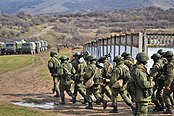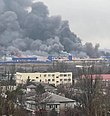
A | B | C | D | E | F | G | H | CH | I | J | K | L | M | N | O | P | Q | R | S | T | U | V | W | X | Y | Z | 0 | 1 | 2 | 3 | 4 | 5 | 6 | 7 | 8 | 9
| Russo-Ukrainian War | |||||||||
|---|---|---|---|---|---|---|---|---|---|
| Part of the conflicts in territory of the former Soviet Union | |||||||||
Clockwise from top left: Ukrainian tanks during the 2022 Kharkiv counteroffensive; Russian military vehicles with Z markings during the 2022 invasion; Russian-backed forces during the Donbas war; Russian bombing during the Siege of Mariupol; Russian soldiers during the invasion of Crimea; Civilians killed by Russian missile strikes on Kyiv | |||||||||
| |||||||||
| Belligerents | |||||||||
|
Supplied by: For countries providing aid to Ukraine since 2022, see military aid to Ukraine |
Supplied by: For details, see Russian military suppliers | ||||||||
| Commanders and leaders | |||||||||
|
| ||||||||
| Strength | |||||||||
|
For details of strengths and units involved at key points in the conflict, see: | |||||||||
| Casualties and losses | |||||||||
| Reports vary widely, but tens of thousands at a minimum.[3][4] See Casualties of the Russo-Ukrainian War for details. | |||||||||
The Russo-Ukrainian War[c] is an ongoing war between Russia and Ukraine, which began in February 2014. Following Ukraine's Revolution of Dignity, Russia occupied and annexed Crimea from Ukraine and supported pro-Russian separatists fighting the Ukrainian military in the Donbas war. The first eight years of conflict also included naval incidents, cyberwarfare, and heightened political tensions. In February 2022, Russia launched a full-scale invasion of Ukraine and began occupying more of the country.
In early 2014, the Euromaidan protests led to the Revolution of Dignity and the ousting of Ukraine's pro-Russian president Viktor Yanukovych. Shortly after, pro-Russian unrest erupted in eastern and southern Ukraine, while unmarked Russian troops occupied Crimea. Russia soon annexed Crimea after a highly disputed referendum. In April 2014, Russian-backed militants seized towns in Ukraine's eastern Donbas region and proclaimed the Donetsk People's Republic (DPR) and the Luhansk People's Republic (LPR) as independent states, starting the Donbas war. The separatists received considerable but covert support from Russia, and Ukrainian attempts to fully retake separatist-held areas failed. Although Russia denied involvement, Russian troops took part in the fighting. In February 2015, Russia and Ukraine signed the Minsk II agreements to end the conflict, but they were never fully implemented in the years that followed. The Donbas war settled into a violent but static conflict between Ukraine and the Russian and separatist forces, with many brief ceasefires but no lasting peace and few changes in territorial control.
Beginning in 2021, Russia built up a large military presence near its border with Ukraine, including within neighbouring Belarus. Russian officials repeatedly denied plans to attack Ukraine. Russian president Vladimir Putin expressed irredentist views and denied Ukraine's right to exist. He criticized the enlargement of NATO and demanded that Ukraine be barred from ever joining the military alliance. Russia recognized the DPR and LPR as independent states.
On 24 February 2022, Putin announced a "special military operation" to "demilitarize and denazify" Ukraine, claiming Russia had no plans to occupy the country. The Russian invasion that followed was internationally condemned; many countries imposed sanctions against Russia and increased existing sanctions. In the face of fierce resistance, Russia abandoned an attempt to take Kyiv in early April. From August, Ukrainian forces began recapturing territories in the north-east and south. In late September, Russia declared the annexation of four partially-occupied regions, which was internationally condemned. Russia spent the winter conducting inconclusive offensives in the Donbas. In spring 2023, Russia dug into positions ahead of another Ukrainian counteroffensive, which failed to gain significant ground. The war has resulted in a refugee crisis and tens of thousands of deaths.
Background
Independent Ukraine and the Orange Revolution

After the dissolution of the Soviet Union (USSR) in 1991, Ukraine and Russia maintained close ties. In 1994, Ukraine agreed to accede to the Treaty on the Non-Proliferation of Nuclear Weapons as a non-nuclear-weapon state.[5] Former Soviet nuclear weapons in Ukraine were removed and dismantled.[6] In return, Russia, the United Kingdom, and the United States agreed to uphold the territorial integrity and political independence of Ukraine through the Budapest Memorandum on Security Assurances.[7][8] In 1999, Russia was one of the signatories of the Charter for European Security, which "reaffirmed the inherent right of each and every participating State to be free to choose or change its security arrangements, including treaties of alliance, as they evolve."[9] In the years after the dissolution of the USSR, several former Eastern Bloc countries joined NATO, partly in response to regional security threats involving Russia such as the 1993 Russian constitutional crisis, the War in Abkhazia (1992–1993) and the First Chechen War (1994–1996). Putin claimed Western powers broke promises not to let any Eastern European countries join.[10][11]
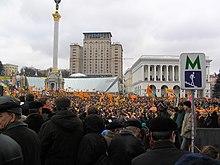
The 2004 Ukrainian presidential election was controversial. During the election campaign, opposition candidate Viktor Yushchenko was poisoned by TCDD dioxin;[12][13] he later accused Russia of involvement.[14] In November, Prime Minister Viktor Yanukovych was declared the winner, despite allegations of vote-rigging by election observers.[15] During a two-month period which became known as the Orange Revolution, large peaceful protests successfully challenged the outcome. After the Supreme Court of Ukraine annulled the initial result due to widespread electoral fraud, a second round re-run was held, bringing to power Yushchenko as president and Yulia Tymoshenko as prime minister, and leaving Yanukovych in opposition.[16] The Orange Revolution is often grouped together with other early-21st century protest movements, particularly within the former USSR, known as colour revolutions. According to Anthony Cordesman, Russian military officers viewed such colour revolutions as attempts by the US and European states to destabilise neighbouring countries and undermine Russia's national security.[17] Russian President Vladimir Putin accused organisers of the 2011–2013 Russian protests of being former advisors to Yushchenko, and described the protests as an attempt to transfer the Orange Revolution to Russia.[18] Rallies in favour of Putin during this period were called "anti-Orange protests".[19]
At the 2008 Bucharest summit, Ukraine and Georgia sought to join NATO. The response among NATO members was divided. Western European countries opposed offering Membership Action Plans (MAP) to Ukraine and Georgia in order to avoid antagonising Russia, while US President George W. Bush pushed for their admission.[20] NATO ultimately refused to offer Ukraine and Georgia MAPs, but also issued a statement agreeing that "these countries will become members of NATO" at some point. Putin strongly opposed Georgia and Ukraine's NATO membership bids.[21] By January 2022, the possibility of Ukraine joining NATO remained remote.[22]
In 2009, Yanukovych announced his intent to again run for president in the 2010 Ukrainian presidential election,[23] which he subsequently won.[24] In November 2013, a wave of large, pro-European Union (EU) protests erupted in response to Yanukovych's sudden decision not to sign the EU–Ukraine Association Agreement, instead choosing closer ties to Russia and the Eurasian Economic Union. On 22 February 2013, the Ukrainian parliament overwhelmingly approved of finalizing Ukraine's agreement with the EU.[25] Subsequently, Russia pressurized Ukraine to reject this agreement by threatening sanctions. Kremlin adviser Sergei Glazyev stated that if the agreement was signed, Russia could not guarantee Ukraine's status as a state.[26][27]
Euromaidan, Revolution of Dignity, and pro-Russian unrest

On 21 February 2014, following months of protests as part of the Euromaidan movement, Yanukovych and the leaders of the parliamentary opposition signed a settlement agreement that provided for early elections. The following day, Yanukovych fled from the capital ahead of an impeachment vote that stripped him of his powers as president.[28][29][30][31] On 23 February, the Rada (Ukrainian Parliament) adopted a bill to repeal the 2012 law which made Russian an official language.[32] The bill was not enacted,[33] but the proposal provoked negative reactions in the Russian-speaking regions of Ukraine,[34] intensified by Russian media claiming that the ethnic Russian population was in imminent danger.[35]
On 27 February, an interim government was established and early presidential elections were scheduled. The following day, Yanukovych resurfaced in Russia and in a press conference, declared that he remained the acting president of Ukraine, just as Russia was commencing a military campaign in Crimea. Leaders of Russian-speaking eastern regions of Ukraine declared continuing loyalty to Yanukovych,[29][36] triggering the 2014 pro-Russian unrest in Ukraine.
Russian military bases in Crimea

At the onset of the Crimean conflict, Russia had roughly 12,000 military personnel from the Black Sea Fleet,[35] in several locations in the Crimean peninsula such as Sevastopol, Kacha, Hvardiiske, Simferopol Raion, Sarych, and others. In 2005 a dispute broke out between Russia and Ukraine over control of the Sarych cape lighthouse near Yalta, and a number of other beacons.[37][38] Russian presence was allowed by the basing and transit agreement with Ukraine. Under this agreement, the Russian military in Crimea was constrained to a maximum of 25,000 troops. Russia was required to respect the sovereignty of Ukraine, honor its legislation, not interfere in the internal affairs of the country, and show their "military identification cards" when crossing the international border.[39] Early in the conflict, the agreement's generous troop limit allowed Russia to significantly strengthen its military presence, deploy special forces and other required capabilities to conduct the operation in Crimea, under the pretext of addressing security concerns.[35]
According to the original treaty on the division of the Soviet Black Sea Fleet signed in 1997, Russia was allowed to have its military bases in Crimea until 2017, after which it would evacuate all military units including its portion of the Black Sea Fleet from the Autonomous Republic of Crimea and Sevastopol. On 21 April 2010, former Ukrainian president Viktor Yanukovych signed a new deal with Russia, known as the Kharkiv Pact, to resolve the 2009 Russia–Ukraine gas dispute. The pact extended Russia's stay in Crimea to 2042, with an option to renew.[40]
Legality and declaration of war
No formal declaration of war has been issued in the ongoing Russo-Ukrainian War. When Putin announced the 2022 Russian invasion of Ukraine, he claimed to commence a "special military operation", side-stepping a formal declaration of war.[41] The statement was, however, regarded as a declaration of war by the Ukrainian government[42] and reported as such by many international news sources.[43][44] While the Ukrainian parliament refers to Russia as a "terrorist state" in regard to its military actions in Ukraine,[45] it has not issued a formal declaration of war on its behalf.
The Russian invasion of Ukraine violated international law (including the Charter of the United Nations).[53][54][55][56] The invasion has also been called a crime of aggression under international criminal law[57] and under some countries' domestic criminal codes – including those of Ukraine and Russia – although procedural obstacles exist to prosecutions under these laws.[58][59]
History
Russian annexation of Crimea (2014)

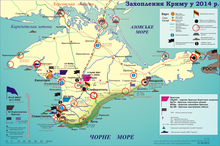

In late February 2014, Russia began to occupy Crimea, marking the beginning of the Russo-Ukrainian War.[60][61][62][63] On 22 and 23 February, in the relative power vacuum immediately after the ousting of Yanukovych,[64] Russian troops and special forces were moved close to the border with Crimea.[62] On 27 February, Russian forces without insignia began to occupy Crimea.[65][66] Russia consistently denied that the soldiers were theirs, instead claiming they were local "self-defense" units. They seized the Crimean parliament and government buildings, as well as setting up checkpoints to restrict movement and cut off the Crimean peninsula from the rest of Ukraine.[67][68][69][70] In the following days, unmarked Russian special forces occupied airports and communications centers,[71] and blockaded Ukrainian military bases, such as the Southern Naval Base. Russian cyberattacks shut down websites associated with the Ukrainian government, news media, and social media. Cyberattacks also enabled Russian access to the mobile phones of Ukrainian officials and members of parliament, further disrupting communications.[72] On 1 March, the Russian parliament approved the use of armed forces in Crimea.[71]
While Russian special forces occupied Crimea's parliament, it dismissed the Crimean government, installed the pro-Russian Aksyonov government, and announced a referendum on Crimea's status. The referendum was held under Russian occupation and, according to the Russian-installed authorities, the result was in favor of joining Russia. It annexed Crimea on 18 March 2014. Following this, Russian forces seized Ukrainian military bases in Crimea and captured their personnel. On 24 March, Ukraine ordered its remaining troops to withdraw; by 30 March, all Ukrainian forces had left the peninsula.
On 15 April, the Ukrainian parliament declared Crimea a territory temporarily occupied by Russia.[73] After the annexation, the Russian government militarized the peninsula and made nuclear threats.[74] Putin said that a Russian military task force would be established in Crimea.[75] In November, NATO stated that it believed Russia was deploying nuclear-capable weapons to Crimea.[76] After the annexation of Crimea, some NATO members began providing training for the Ukrainian army.[77]
War in the Donbas (2014–2015)
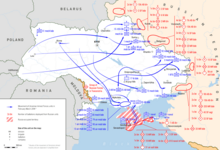
Pro-Russia unrest
From late February 2014, demonstrations by pro-Russian and anti-government groups took place in major cities across the eastern and southern regions of Ukraine.[78] The first protests across southern and eastern Ukraine were largely native expressions of discontent with the new Ukrainian government.[78][79] Russian involvement at this stage was limited to voicing support for the demonstrations.[79][80] Russia exploited this, however, launching a coordinated political and military campaign against Ukraine.[79][81] Putin gave legitimacy to the separatists when he described the Donbas as part of "New Russia" (Novorossiya), and expressed bewilderment as to how the region had ever become part of Ukraine.[82]
Russia continued to marshal forces near Ukraine's eastern border in late March, reaching 30–40,000 troops by April.[83][35] The deployment was used to threaten escalation and disrupt Ukraine's response.[35] This threat forced Ukraine to divert forces to its borders instead of the conflict zone.[35]
Ukrainian authorities cracked down on the pro-Russian protests and arrested local separatist leaders in early March. Those leaders were replaced by people with ties to the Russian security services and interests in Russian businesses.[84] By April 2014, Russian citizens had taken control of the separatist movement, supported by volunteers and materiel from Russia, including Chechen and Cossack fighters.[85][86][87][88] According to Donetsk People's Republic (DPR) commander Igor Girkin, without this support in April, the movement would have dissipated, as it had in Kharkiv and Odesa.[89] The separatist groups held disputed referendums in May,[90][91][92] which were not recognised by Ukraine or any other UN member state.[90]
Armed conflict

In April 2014, armed conflict began in eastern Ukraine between Russian-backed separatists and Ukraine. On 12 April, a fifty-man unit of pro-Russian militants seized the towns of Sloviansk and Kramatorsk.[93] The heavily armed men were Russian Armed Forces "volunteers" under the command of former GRU colonel Igor Girkin ('Strelkov').[93][94] They had been sent from Russian-occupied Crimea and wore no insignia.[93] Girkin said that this action sparked the Donbas War. He said "I'm the one who pulled the trigger of war. If our unit hadn't crossed the border, everything would have fizzled out".[95][96]

In response, on 15 April the interim Ukrainian government launched an "Anti-Terrorist Operation" (ATO); however, Ukrainian forces were poorly prepared and ill-positioned and the operation quickly stalled.[97] By the end of April, Ukraine announced it had lost control of the provinces of Donetsk and Luhansk. It claimed to be on "full combat alert" against a possible Russian invasion and reinstated conscription to its armed forces.[98] During May, the Ukrainian campaign focused on containing the separatists by securing key positions around the ATO zone to position the military for a decisive offensive once Ukraine's national mobilization had completed.
As conflict between the separatists and the Ukrainian government escalated in May, Russia began to employ a "hybrid approach", combining disinformation tactics, irregular fighters, regular Russian troops, and conventional military support.[99][100][101] The First Battle of Donetsk Airport followed the Ukrainian presidential elections. It marked a turning point in conflict; it was the first battle between the separatists and the Ukrainian government that involved large numbers of Russian "volunteers".[102][103]: 15 According to Ukraine, at the height of the conflict in the summer of 2014, Russian paramilitaries made up between 15% and 80% of the combatants.[87] From June Russia trickled in arms, armor, and munitions.
On 17 July 2014, Russian-controlled forces shot down a passenger aircraft, Malaysia Airlines Flight 17, as it was flying over eastern Ukraine.[104] Investigations and the recovery of bodies began in the conflict zone as fighting continued.[105][106][107]
By the end of July, Ukrainian forces were pushing into cities, to cut off supply routes between the two, isolating Donetsk and attempting to restore control of the Russo-Ukrainian border. By 28 July, the strategic heights of Savur-Mohyla were under Ukrainian control, along with the town of Debaltseve, an important railroad hub.[108] These operational successes of Ukrainian forces threatened the existence of the DPR and LPR statelets, prompting Russian cross-border shelling targeted at Ukrainian troops on their own soil, from mid-July onwards.[109]
August 2014 Russian invasion

After a series of military defeats and setbacks for the separatists, who united under the banner of "Novorossiya",[110][111] Russia dispatched what it called a "humanitarian convoy" of trucks across the border in mid-August 2014. Ukraine called the move a "direct invasion".[112] Ukraine's National Security and Defence Council reported that convoys were arriving almost daily in November (up to 9 convoys on 30 November) and that their contents were mainly arms and ammunition. Strelkov claimed that in early August, Russian servicemen, supposedly on "vacation" from the army, began to arrive in Donbas.[113]
By August 2014, the Ukrainian "Anti-Terrorist Operation" shrank the territory under pro-Russian control, and approached the border.[114] Igor Girkin urged Russian military intervention, and said that the combat inexperience of his irregular forces, along with recruitment difficulties amongst the local population, had caused the setbacks. He stated, "Losing this war on the territory that President Vladimir Putin personally named New Russia would threaten the Kremlin's power and, personally, the power of the president".[115]
In response to the deteriorating situation, Russia abandoned its hybrid approach, and began a conventional invasion on 25 August 2014.[114][116] On the following day, the Russian Defence Ministry said these soldiers had crossed the border "by accident".[117][118][119] According to Nikolai Mitrokhin's estimates, by mid-August 2014 during the Battle of Ilovaisk, between 20,000 and 25,000 troops were fighting in the Donbas on the separatist side, and only 40–45% were "locals".[120]
On 24 August 2014, Amvrosiivka was occupied by Russian paratroopers,[121] supported by 250 armoured vehicles and artillery pieces.[122] The same day, Ukrainian President Petro Poroshenko referred to the operation as Ukraine's "Patriotic War of 2014" and a war against external aggression.[123][124] On 25 August, a column of Russian military vehicles was reported to have crossed into Ukraine near Novoazovsk on the Azov sea coast. It appeared headed towards Ukrainian-held Mariupol,[125][126][127][128][129] in an area that had not seen pro-Russian presence for weeks.[130] Russian forces captured Novoazovsk.[131] and Russian soldiers began deporting Ukrainians who did not have an address registered within the town.[132] Pro-Ukrainian anti-war protests took place in Mariupol.[132][133] The UN Security Council called an emergency meeting.[134]

The Pskov-based 76th Guards Air Assault Division allegedly entered Ukrainian territory in August and engaged in a skirmish near Luhansk, suffering 80 dead. The Ukrainian Defence Ministry said that they had seized two of the unit's armoured vehicles near Luhansk, and reported destroying another three tanks and two armoured vehicles in other regions.[135]
The speaker of Russia's upper house of parliament and Russian state television channels acknowledged that Russian soldiers entered Ukraine, but referred to them as "volunteers".[136] A reporter for Novaya Gazeta, an opposition newspaper in Russia, stated that the Russian military leadership paid soldiers to resign their commissions and fight in Ukraine in the early summer of 2014, and then began ordering soldiers into Ukraine.[137] Russian opposition MP Lev Shlosberg made similar statements, although he said combatants from his country are "regular Russian troops", disguised as units of the DPR and LPR.[138]
In early September 2014, Russian state-owned television channels reported on the funerals of Russian soldiers who had died in Ukraine, but described them as "volunteers" fighting for the "Russian world". Valentina Matviyenko, a top United Russia politician, also praised "volunteers" fighting in "our fraternal nation".[136] Russian state television for the first time showed the funeral of a soldier killed fighting in Ukraine.[139]
Mariupol offensive and first Minsk ceasefire

On 3 September, Poroshenko said he and Putin had reached a "permanent ceasefire" agreement.[140] Russia denied this, denying that it was a party to the conflict, adding that "they only discussed how to settle the conflict".[141][142] Poroshenko then recanted.[143][144] On 5 September Russia's Permanent OSCE Representative Andrey Kelin, said that it was natural that pro-Russian separatists "are going to liberate" Mariupol. Ukrainian forces stated that Russian intelligence groups had been spotted in the area. Kelin said 'there might be volunteers over there.'[145] On 4 September 2014, a NATO officer said that several thousand regular Russian forces were operating in Ukraine.[146]
On 5 September 2014, the Minsk Protocol ceasefire agreement drew a line of demarcation between Ukraine and separatist-controlled portions of Donetsk and Luhansk Oblasts.
End of 2014 and Minsk II agreement
On 7 and 12 November, NATO officials reconfirmed the Russian presence, citing 32 tanks, 16 howitzer cannons and 30 trucks of troops entering the country.[147] US general Philip M. Breedlove said "Russian tanks, Russian artillery, Russian air defence systems and Russian combat troops" had been sighted.[76][148] NATO said it had seen an increase in Russian tanks, artillery pieces and other heavy military equipment in Ukraine and renewed its call for Moscow to withdraw its forces.[149] The Chicago Council on Global Affairs stated that Russian separatists enjoyed technical advantages over the Ukrainian army since the large inflow of advanced military systems in mid-2014: effective anti-aircraft weapons ("Buk", MANPADS) suppressed Ukrainian air strikes, Russian drones provided intelligence, and Russian secure communications system disrupted Ukrainian communications intelligence. The Russian side employed electronic warfare systems that Ukraine lacked. Similar conclusions about the technical advantage of the Russian separatists were voiced by the Conflict Studies Research Centre.[150] At the United Nations Security Council meeting on 12 November, the United Kingdom's representative accused Russia of intentionally constraining OSCE observation missions' capabilities, stating that the observers were allowed to monitor only two kilometers of border, and drones deployed to extend their capabilities were jammed or shot down.[151][non-primary source needed]

In January 2015, Donetsk, Luhansk, and Mariupol represented the three battle fronts.[153] Poroshenko described a dangerous escalation on 21 January amid reports of more than 2,000 additional Russian troops, 200 tanks and armed personnel carriers crossing the border. He abbreviated his visit to the World Economic Forum because of his concerns.[154]
A new package of measures to end the conflict, known as Minsk II, was agreed on 15 February 2015.[155] On 18 February, Ukrainian forces withdrew from Debatlseve, in the last high-intensity battle of the Donbas war until 2022. In September 2015 the United Nations Human Rights Office estimated that 8000 casualties had resulted from the conflict.[156]
Line of conflict stabilizes (2015–2021)
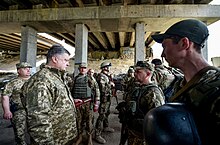
After the Minsk agreements, the war settled into static trench warfare around the agreed line of contact, with few changes in territorial control. The conflict was marked by artillery duels, special forces operations, and trench warfare. Hostilities never ceased for a substantial period of time, but continued at a low level despite repeated attempts at ceasefire. In the months after the fall of Debaltseve, minor skirmishes continued along the line of contact, but no territorial changes occurred. Both sides began fortifying their position by building networks of trenches, bunkers and tunnels, turning the conflict into static trench warfare.[157][158] The relatively static conflict was labelled "frozen" by some,[159] but Russia never achieved this as the fighting never stopped.[160][161] Between 2014 and 2022 there were 29 ceasefires, each agreed to remain in force indefinitely. However, none of them lasted more than two weeks.[162]
US and international officials continued to report the active presence of Russian military in eastern Ukraine, including in the Debaltseve area.[163] In 2015, Russian separatist forces were estimated to number around 36,000 troops (compared to 34,000 Ukrainian), of whom 8,500–10,000 were Russian soldiers. Additionally, around 1,000 GRU troops were operating in the area.[164] Another 2015 estimate held that Ukrainian forces outnumbered Russian forces 40,000 to 20,000.[165] In 2017, on average one Ukrainian soldier died in combat every three days,[166] with an estimated 6,000 Russian and 40,000 separatist troops in the region.[167][168]

Cases of killed and wounded Russian soldiers were discussed in local Russian media.[169] Recruiting for Donbas was performed openly via veteran and paramilitary organisations. Vladimir Yefimov, leader of one such organisation, explained how the process worked in the Ural area. The organisation recruited mostly army veterans, but also policemen, firefighters etc. with military experience. The cost of equipping one volunteer was estimated at 350,000 rubles (around $6500) plus salary of 60,000 to 240,000 rubles per month.[170] The recruits received weapons only after arriving in the conflict zone. Often, Russian troops traveled disguised as Red Cross personnel.[171][172][173][174] Igor Trunov, head of the Russian Red Cross in Moscow, condemned these convoys, saying they complicated humanitarian aid delivery.[175] Russia refused to allow OSCE to expand its mission beyond two border crossings.[176]
The volunteers were issued a document claiming that their participation was limited to "offering humanitarian help" to avoid Russian mercenary laws. Russia's anti-mercenary legislation defined a mercenary as someone who "takes part with aims counter to the interests of the Russian Federation".[170]
In August 2016, the Ukrainian intelligence service, the SBU, published telephone intercepts from 2014 of Sergey Glazyev (Russian presidential adviser), Konstantin Zatulin, and other people in which they discussed covert funding of pro-Russian activists in Eastern Ukraine, the occupation of administration buildings and other actions that triggered the conflict.[177] As early as February 2014, Glazyev gave direct instructions to various pro-Russian parties on how to take over local administration offices, what to do afterwards, how to formulate demands, and promised support from Russia, including "sending our guys".[178][179][180]

2018 Kerch Strait incident

Russia gained de facto control of the Kerch Strait in 2014. In 2017, Ukraine appealed to a court of arbitration over the use of the strait. By 2018 Russia had built a bridge over the strait, limiting the size of ships that could pass through, imposed new regulations, and repeatedly detained Ukrainian vessels.[181] On 25 November 2018, three Ukrainian boats traveling from Odesa to Mariupol were seized by Russian warships; 24 Ukrainian sailors were detained.[182][183] A day later on 26 November 2018, the Ukrainian parliament overwhelmingly backed the imposition of martial law along Ukraine's coastal regions and those bordering Russia.[184]
2019–2020
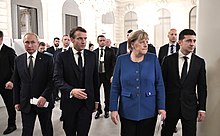
More than 110 Ukrainian soldiers were killed in the conflict in 2019.[185] In May 2019, newly elected Ukrainian President Volodymyr Zelenskyy took office promising to end the war in Donbas.[185] In December 2019, Ukraine and pro-Russian separatists began swapping prisoners of war. Around 200 prisoners were exchanged on 29 December 2019.[186][187][188][189] According to Ukrainian authorities, 50 Ukrainian soldiers were killed in 2020.[190] Between 2019 and 2021, Russia issued over 650,000 internal Russian passports to Ukrainians.[191][192]
There were 27 conflict-related civilian deaths in 2019, 26 deaths in 2020, and 25 deaths in 2021, over half of them from mines and unexploded ordnance.[193]
Russian military buildup around Ukraine (2021–2022)
From March to April 2021, Russia commenced a major military build-up near the border, followed by a second build-up between October 2021 to February 2022 in Russia and Belarus.[194] Throughout, the Russian government repeatedly denied it had plans to attack Ukraine.[195][196]
In early December 2021, following Russian denials, the US released intelligence of Russian invasion plans, including satellite photographs showing Russian troops and equipment near the border.[197] The intelligence reported a Russian list of key sites and individuals to be killed or neutralized.[198] The US released multiple reports that accurately predicted the invasion plans.[198]
Russian accusations and demands

In the months preceding the invasion, Russian officials accused Ukraine of inciting tensions, Russophobia, and repressing Russian speakers. They made multiple security demands of Ukraine, NATO, and other EU countries. On 9 December 2021 Putin said that "Russophobia is a first step towards genocide".[199][200] Putin's claims were dismissed by the international community,[201] and Russian claims of genocide were rejected as baseless.[202][203][204] In a 21 February speech,[205] Putin questioned the legitimacy of the Ukrainian state, repeating an inaccurate claim that "Ukraine never had a tradition of genuine statehood".[206] He incorrectly stated that Vladimir Lenin had created Ukraine, by carving a separate Soviet Republic out of what Putin said was Russian land, and that Nikita Khrushchev "took Crimea away from Russia for some reason and gave it to Ukraine" in 1954.[207]
Putin falsely claimed that Ukrainian society and government were dominated by neo-Nazism, invoking the history of collaboration in German-occupied Ukraine during World War II,[208][209] and echoing an antisemitic conspiracy theory that cast Russian Christians, rather than Jews, as the true victims of Nazi Germany.[210][201] Ukraine does have a far-right fringe, including the neo-Nazi linked Azov Battalion and Right Sector.[211][209] Analysts described Putin's rhetoric as greatly exaggerated.[212][208] Zelenskyy, who is Jewish, stated that his grandfather served in the Soviet army fighting against the Nazis;[213] three of his family members were killed in the Holocaust.[212]

During the second build-up, Russia demanded a treaty that would forbid Ukraine from ever joining NATO, and end all NATO activity in its Eastern European member states.[215] These demands were rejected.[216] A treaty to prevent Ukraine joining NATO would go against the alliance's "open door" policy and the principle of self-determination, although NATO made no efforts to comply with Ukraine's requests to join.[217] NATO Secretary General Jens Stoltenberg replied that "Russia has no say" on whether Ukraine joins, and that "Russia has no right to establish a sphere of influence to try to control their neighbors".[218] NATO offered to improve communications with Russia and discuss missile placements and military exercises, as long as Russia withdrew troops from Ukraine's borders,[219] but Russia did not withdraw.
Prelude to full invasion
Fighting in Donbas escalated significantly from 17 February 2022 onwards.[220] The Ukrainians and the pro-Russian separatists each accused the other of attacks.[221][222] There was a sharp increase in artillery shelling by the Russian-led militants in Donbas, which was considered by Ukraine and its supporters to be an attempt to provoke the Ukrainian army or create a pretext for invasion.[223][224][225] On 18 February, the Donetsk and Luhansk people's republics ordered mandatory emergency evacuations of civilians from their respective capital cities,[226][227][228] although observers noted that full evacuations would take months.[229] The Russian government intensified its disinformation campaign, with Russian state media promoting fabricated videos (false flags) on a nearly hourly basis purporting to show Ukrainian forces attacking Russia.[230] Many of the disinformation videos were amateurish, and evidence showed that the claimed attacks, explosions, and evacuations in Donbas were staged by Russia.[230][231][232]
On 21 February at 22:35 (UTC+3),[233] Putin announced that the Russian government would diplomatically recognize the Donetsk and Luhansk people's republics.[234] The same evening, Putin directed that Russian troops deploy into Donbas, in what Russia referred to as a "peacekeeping mission".[235][236] On 22 February, the Federation Council unanimously authorised Putin to use military force outside Russia.[237] In response, Zelenskyy ordered the conscription of army reservists;[238] The following day, Ukraine's parliament proclaimed a 30-day nationwide state of emergency and ordered the mobilisation of all reservists.[239][240][241] Russia began to evacuate its embassy in Kyiv.[242]
On the night of 23 February,[243] Zelenskyy gave a speech in Russian in which he appealed to the citizens of Russia to prevent war.[244][245] He rejected Russia's claims about neo-Nazis and stated that he had no intention of attacking the Donbas.[246] Kremlin spokesman Dmitry Peskov said on 23 February that the separatist leaders in Donetsk and Luhansk had sent a letter to Putin stating that Ukrainian shelling had caused civilian deaths and appealing for military support.[247]
Full-scale Russian invasion of Ukraine (2022–present)
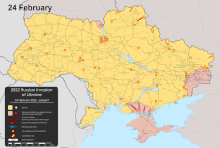

The Russian invasion of Ukraine began on the morning of 24 February 2022,[248] when Putin announced a "special military operation" to "demilitarise and denazify" Ukraine.[249][250] Minutes later, missiles and airstrikes hit across Ukraine, including Kyiv, shortly followed by a large ground invasion along multiple fronts.[251][252] Zelenskyy declared martial law and a general mobilisation of all male Ukrainian citizens between 18 and 60, who were banned from leaving the country.[253][254]
Russian attacks were initially launched on a northern front from Belarus towards Kyiv, a southern front from Crimea, and a south-eastern front from Luhansk and Donetsk and towards Kharkiv.[255][256] In the northern front, amidst heavy losses and strong Ukrainian resistance surrounding Kyiv, Russia's advance stalled in March, and by April its troops retreated. On 8 April, Russia placed its forces in southern and eastern Ukraine under the command of General Aleksandr Dvornikov, and some units withdrawn from the north were redeployed to the Donbas.[257] On 19 April, Russia launched a renewed attack across a 500 kilometres (300 mi) long front extending from Kharkiv to Donetsk and Luhansk.[258] By 13 May, a Ukraine counter-offensive had driven back Russian forces near Kharkiv. By 20 May, Mariupol fell to Russian troops following a prolonged siege of the Azovstal steel works.[259][260] Russian forces continued to bomb both military and civilian targets far from the frontline.[261][262] The war caused the largest refugee and humanitarian crisis within Europe since the Yugoslav Wars in the 1990s;[263][264] the UN described it as the fastest-growing such crisis since World War II.[265] In the first week of the invasion, the UN reported over a million refugees had fled Ukraine; this subsequently rose to over 7,405,590 by 24 September, a reduction from over eight million due to some refugees' return.[266][267]

Ukrainian forces launched counteroffensives in the south in August, and in the northeast in September. On 30 September, Russia annexed four oblasts of Ukraine which it had partially conquered during the invasion.[268] This annexation was generally unrecognized and condemned by the countries of the world.[269] After Putin announced that he would begin conscription drawn from the 300,000 citizens with military training and potentially the pool of about 25 million Russians who could be eligible for conscription, one-way tickets out of the country nearly or completely sold out.[270][271] The Ukrainian offensive in the northeast successfully recaptured the majority of Kharkiv Oblast in September. In the course of the southern counteroffensive, Ukraine retook the city of Kherson in November and Russian forces withdrew to the east bank of the Dnieper River.[citation needed]
The invasion was internationally condemned as a war of aggression.[272][273] A United Nations General Assembly resolution demanded a full withdrawal of Russian forces, the International Court of Justice ordered Russia to suspend military operations and the Council of Europe expelled Russia. Many countries imposed new sanctions, which affected the economies of Russia and the world,[274] and provided humanitarian and military aid to Ukraine.[275] In September 2022, Putin signed a law that would punish anyone who resists conscription with a 10-year prison sentence[276] resulting in an international push to allow asylum for Russians fleeing conscription.[277]
As of August 2023, the total number of Russian and Ukrainian soldiers killed or wounded during the Russian invasion of Ukraine was nearly 500,000.[278] More than 10,000 civilians were killed during the Russian invasion of Ukraine.[279] According to a declassified US intelligence assessment, as of December 2023, Russia had lost 315,000 of the 360,000 troops that made up Russia's pre-invasion ground force, and 2,200 of the 3,500 tanks.[280]
Human rights violations
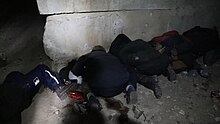
Violations of human rights and atrocity crimes have both occurred during the war. From 2014 to 2021, there were more than 3,000 civilian casualties, with most occurring in 2014 and 2015.[281] The right of movement was impeded for the inhabitants of the conflict zone.[282] Arbitrary detention was practiced by both sides in the first years of the conflict. It decreased after 2016 in government-held areas, while in the separatist-held ones it continued.[283] Investigations into the abuses committed by both sides made little progress.[284][285]
Zdroj:https://en.wikipedia.org?pojem=Russo-Ukrainian_WarText je dostupný za podmienok Creative Commons Attribution/Share-Alike License 3.0 Unported; prípadne za ďalších podmienok. Podrobnejšie informácie nájdete na stránke Podmienky použitia.
Antropológia
Aplikované vedy
Bibliometria
Dejiny vedy
Encyklopédie
Filozofia vedy
Forenzné vedy
Humanitné vedy
Knižničná veda
Kryogenika
Kryptológia
Kulturológia
Literárna veda
Medzidisciplinárne oblasti
Metódy kvantitatívnej analýzy
Metavedy
Metodika
Text je dostupný za podmienok Creative
Commons Attribution/Share-Alike License 3.0 Unported; prípadne za ďalších
podmienok.
Podrobnejšie informácie nájdete na stránke Podmienky
použitia.
www.astronomia.sk | www.biologia.sk | www.botanika.sk | www.dejiny.sk | www.economy.sk | www.elektrotechnika.sk | www.estetika.sk | www.farmakologia.sk | www.filozofia.sk | Fyzika | www.futurologia.sk | www.genetika.sk | www.chemia.sk | www.lingvistika.sk | www.politologia.sk | www.psychologia.sk | www.sexuologia.sk | www.sociologia.sk | www.veda.sk I www.zoologia.sk





